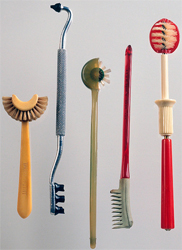~Irish Saying
Soda bread was not invented by the Irish. The first reference to soda bread is credited to American Indians. The Irish have, however, made soda bread an Irish tradition. Not so much by choice as out of necessity.
During times of poverty and famine in Ireland hard flour - the type that is needed to use with yeast to make it rise, was largely unaffordable. The wheat that grows in the Irish climate is soft wheat which is low in gluten. The acidic properties of bicarbonite soda and sour milk (buttermilk) work to create a reaction that leavens bread made with soft flour.
Here is the soda bread recipe I made today:
- 4 cups all-purpose flour
- 1 teaspoon baking soda
- 1 tablespoon baking powder
- 1/2 teaspoon salt
- 1/2 cup butter, softened
- 1 1/2 cup buttermilk
- 1 egg
- 1/4 cup butter, melted
- 1/4 cup buttermilk
Mix flour, baking soda, baking powder, salt and 1/2 cup butter. Stir in buttermilk and egg. Turn dough out onto a lightly floured surface and slightly knead. Form dough and place on a lightly greased baking sheet.
Combine melted butter with 1/4 cup buttermilk and brush loaf with this mixture. Use a sharp knife to cut an 'X' into the top of the loaf.
Bake in preheated oven for 45 to 50 minutes. It turned out okay. It looked terrible, but tasted fine!
Note: That is an interrobang in the title - a combined question mark and exclamation mark for when on or the other will not do.






